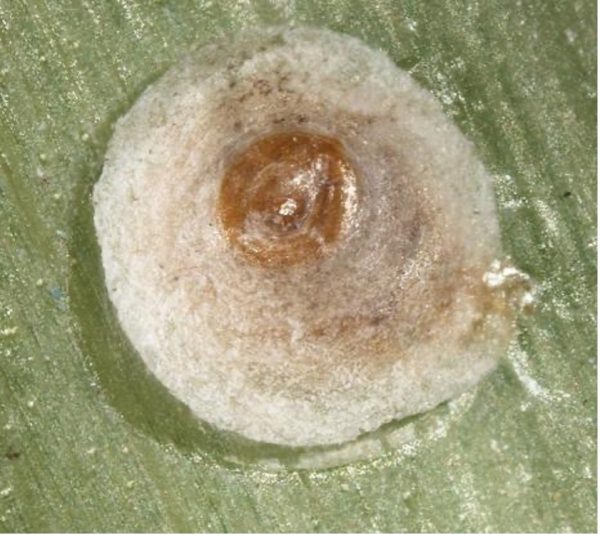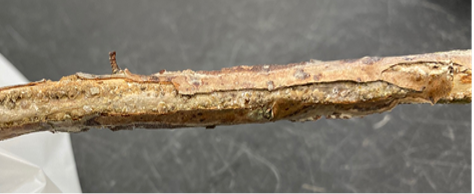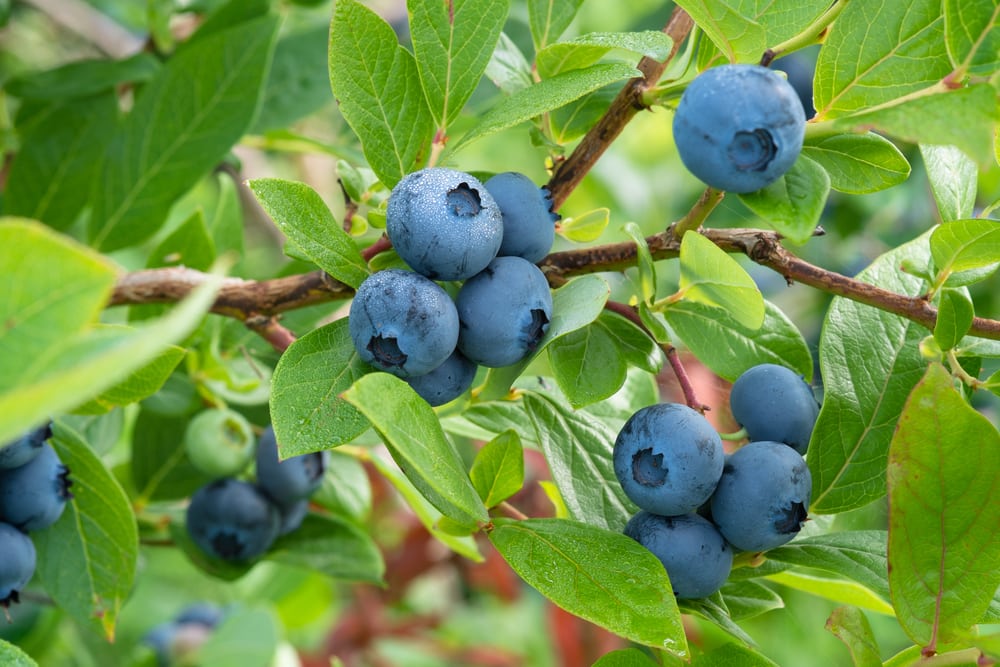Crop Production


Figure 1. A single latania scale insect.
Charles Olsen, USDA APHIS PPQ, Bugwood.org
Latania scale occurs in all tropical regions of the world. It is a general feeder, commonly found on a variety of woody twigs. Latania scale (figure 1) infests over 600 hosts worldwide and was found to heavily damage plants in Alabama blueberry orchards.
Damage
The first sign of latania scale is the presence of armor (a covering of wax, other chemical compounds and the shed skins of earlier stages) on upper and lower leaf surfaces, fruits, and stems of plants. Armored scales feed on the contents of individual plant cells and cause a loss of vigor, deformation of infested plant parts, yellowish spots on leaves, defoliation, and even death of the plant. According to Charles Ray, a former Alabama Extension entomologist, growers are probably going to start seeing more scale problems in fruits treated for spotted wing drosophila (SWD) because the insecticides are killing some or many of the natural enemies. On heavily infested blueberry canes (figure 2), feeding damage causes the appearance that the scales are pushing the bark off.
Biology

Figure 2. Latania scale damage on a blueberry cane.
The number of days for each developmental stage and the number of generations per year depend on temperature, humidity, and rainfall. Based on a generalized life cycle of other tropical species, 30 days is the approximate time to complete the life cycle from egg to reproducing adult. Eggs are laid under the armor of the female where they develop and hatch into the crawler stage. Crawlers may stay under the maternal armor for several hours until outside conditions, especially temperature and humidity, are favorable. After they leave the cover, they wander for a few hours. At the end of the wandering period, they flatten against the leaf or stem and begin to secrete their armor. Newly settled nymphs insert their piercing-sucking mouthparts into plant tissue and start feeding on plant juices. Female latania scales are legless and appear larvae-like. They remain under armor in one place throughout their lives to feed and reproduce. Males are different in appearance and behavior from females. They do not feed, and they live for only a few hours to mate.
Behavior
Since female armored scales are not capable of relocating once settled, long-range dispersal of adults happens by passive transport of infested plant material. Short range dispersal is by crawlers as they search for places to settle and feed. Within an orchard, the crawlers are primarily dispersed by wind currents. It is the crawler stage that can be carried directly from place to place by people, animals, birds, ants, and wind currents.
Management
Cultural Control
Since armored scales are spread chiefly through movement of nursery stock, only propagative material that is free of scales should be planted. Adequate plant spacing is important, because armored scales seldom spread from plant to plant unless the crowns of the plants are in contact with each other. As plants grow, pruning maintains spacing and allows maximum coverage when using insecticides.
Residential Recommendations
The tiny aphelinid wasp, Aphytis diaspidis, is a relatively common parasite of armored scale insects. The ladybird beetle, Chilocorus stigma, also feeds on latania scale as well as other scale insects. If these or other natural enemies fail to adequately control latania scales, it is fortunate these scales are not particularly resistant to insecticides. Horticultural oils can provide adequate control. Apply a horticultural oil on the next day with favorable conditions as described by the label and then again two weeks later to kill any scales that may have been in the egg stage during the first application. Use a 2 percent rate of oil during the growing season in order to avoid damaging the plants. During the winter, most plants are tolerant of the dormant oil rate of 3 percent by volume.
For more detailed management options, see the 2023 Southeast Regional Blueberry Integrated Pest Management Guide.

